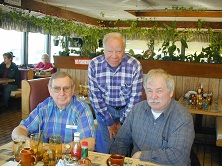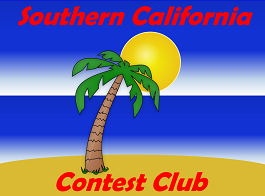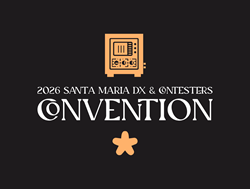Southern California Contest Club
WW Digi DX Contest: August 30-31 All Asian DX Contest, Phone: September 6-7 NA Sprint CW: September 14
WW Digi DX Contest: August 30-31 All Asian DX Contest, Phone: September 6-7 NA Sprint CW: September 14
Past Feature Stories (Newest to Oldest)
Building a HamClock on a Pi Computer by Dennis, NE6I
April 2024
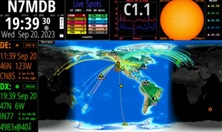 Back in April, 2022, I presented an article about Veritium's HFClock. I still use it to this day and find it to be a very nifty addition to the ham shack. HFClock is much, much, much more than just a clock. You can read more about it in that 2022 article. Turns out, you can get the same thing from Inovato on their web site. They call it the Quadra HamClock bundle. You see, the software author, WB0OEW, actually calls his software HamClock. Inovato packages this on a small Quadra PC for the amazingly low price of $49! You might need a power supply and some cables, or you can buy their bundle. The keyboard is pretty tiny and you'll probably want to use one that you already have. Their products can be found on their website. Or, you can build one yourself!
Back in April, 2022, I presented an article about Veritium's HFClock. I still use it to this day and find it to be a very nifty addition to the ham shack. HFClock is much, much, much more than just a clock. You can read more about it in that 2022 article. Turns out, you can get the same thing from Inovato on their web site. They call it the Quadra HamClock bundle. You see, the software author, WB0OEW, actually calls his software HamClock. Inovato packages this on a small Quadra PC for the amazingly low price of $49! You might need a power supply and some cables, or you can buy their bundle. The keyboard is pretty tiny and you'll probably want to use one that you already have. Their products can be found on their website. Or, you can build one yourself!
more
Today, I'm going to walk you through the steps to build your own. It will cost you more than Inovato's product, which by the say, comes bundled with some other software too, but building your own is more fun if you're a builder/tinkerer and you have the flexibility of also loading other software of your choice on it. As I mentioned, Inovato's proudct is built on a Quadra PC. Veritium's, which costs much more than building your own, is built on a Pi computer. You could of course buy your own Quadra computer and install the software but in this article, I will describe doing it on a Raspberry Pi. Assuming you have some of what you need laying around, you can probably rival the cost of Inovato's product. But if not, it's not going to break the bank.
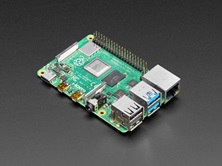 You'll need a Pi computer. I purchased one from Adafruit. I decided to get the Pi 4 B with 4 GB of RAM (currently $55). WB0OEW tells me the software will run on 1 and 2 GB Pi units, albeit a bit slower. I also purchased their Model 4553 Flirc Aluminum case ($14.95) and Model 5801 Vertical Wall Power Supply ($5.95). (Note, I have not noticed any increase in RF noise or birdies at my QTH with this "wall wart.") It's a 5 VDC supply with a micro-USB connector; something that you possibly have laying around (I didn't). You will also need a micro-HDMI male to HDMI female adapter so that you can connect an HDMI monitor of your choosing into the Pi. I purchased this one on Amazon for five bucks. And you will need a micro-SD card (32 GB is what I used), a micro-SD to SD adapter or a micro-SD to USB adapter for programming it.
You'll need a Pi computer. I purchased one from Adafruit. I decided to get the Pi 4 B with 4 GB of RAM (currently $55). WB0OEW tells me the software will run on 1 and 2 GB Pi units, albeit a bit slower. I also purchased their Model 4553 Flirc Aluminum case ($14.95) and Model 5801 Vertical Wall Power Supply ($5.95). (Note, I have not noticed any increase in RF noise or birdies at my QTH with this "wall wart.") It's a 5 VDC supply with a micro-USB connector; something that you possibly have laying around (I didn't). You will also need a micro-HDMI male to HDMI female adapter so that you can connect an HDMI monitor of your choosing into the Pi. I purchased this one on Amazon for five bucks. And you will need a micro-SD card (32 GB is what I used), a micro-SD to SD adapter or a micro-SD to USB adapter for programming it.
BTW, you can purchase Pi computers, cases, supplies, etc. from several sources including Gigaparts. I just happened to shop at Adafruit which was one of several online shops suggested to me.
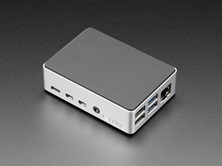
Once you have the hardware on hand, install the Pi computer board into the case using the four included screws, and then install the case cover. Before powering up your new Pi, you'll need to install the operating system (OS) onto the micro-SD card. To do so, download the Raspberry Pi Imager software at www.raspberrypi.com/software. I'm a Windows guy, so I downloaded the Windows version. If you are installing on Windows or Mac, ignore the blurb on the webpage about installing Raspberry Pi OS using a Terminal window. If you're going to do it on a Linux box, then yes, you would follow that instruction.
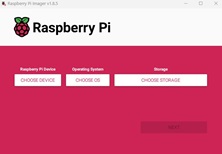 Now that you have downloaded and installed the Imager, run it. You will have a window like that to the right. Plug your micro-SD card and adapter into your desktop or laptop where you have installed Imager. In Imager, click on CHOOSE DEVICE and select Raspberry Pi 4 (Models B, 400, and Computer Modules 4, 4S). Next click on CHOOSE OS and select Raspberry Pi OS (64 bit). This will give you a GUI on your new Pi. Next click on CHOOSE STORAGE. You will want to be VERY CAREFUL here and select your micro-SD card. I repeat, be very careful to select your micro-SD card!!! If you inadvertently choose your hard drive or SSD or anything other than the micro-SD card and go forth with imaging, you will erase and overwrite everying on that drive! And you will be hating life! So...if you are using a micro-SD card that you had laying around your shack, be sure it doesn't have some important software or data on it because, yes, everything on that card will be erased and overwritten! Fortunately, Imager will give you a warning before proceeding with imaging. Click NEXT.
Now that you have downloaded and installed the Imager, run it. You will have a window like that to the right. Plug your micro-SD card and adapter into your desktop or laptop where you have installed Imager. In Imager, click on CHOOSE DEVICE and select Raspberry Pi 4 (Models B, 400, and Computer Modules 4, 4S). Next click on CHOOSE OS and select Raspberry Pi OS (64 bit). This will give you a GUI on your new Pi. Next click on CHOOSE STORAGE. You will want to be VERY CAREFUL here and select your micro-SD card. I repeat, be very careful to select your micro-SD card!!! If you inadvertently choose your hard drive or SSD or anything other than the micro-SD card and go forth with imaging, you will erase and overwrite everying on that drive! And you will be hating life! So...if you are using a micro-SD card that you had laying around your shack, be sure it doesn't have some important software or data on it because, yes, everything on that card will be erased and overwritten! Fortunately, Imager will give you a warning before proceeding with imaging. Click NEXT.
The next screen will ask "Use OS customisation?" Click on EDIT SETTINGS. On the GENERAL tab, leave Set hostname unchecked. Check the box "Set username and password." You can use whatever username and password you like. I just chose "Pi" as the username and a relatively easy to remember password. If you are desiring to use your wi-fi, check the box for "Configure wireless LAN." Manually type in your wifi SSID. Then type in your wifi password. Select US for "Wireless LAN country." (This selects the correct wifi frequencies here in the USA.) If you are going to use a CAT5 cable to go directly to your router, you can skip this step and leave "Configure wireless LAN" unchecked. Now check the box for "Set locale settings" and choose America/Los_Angeles for the timezone and US for the keyboard layout. On the SERVICES tab, leave Enable SSH unchecked. On the OPTIONS tab, click any you like. Then click SAVE. This takes you back to the "Use OS customization" window. Click on YES.
Here comes your warning that "All existing data on your storage device will be erased. Are you sure you want to continue?" If you are sure it's your micro-SD vard, click YES. If not, click NO and go back to change to the correct device.
If you are using a USB 2.0 adapter, it's going to take 30-45 minutes to write the Raspberry Pi OS to the micro-SD card. So, take a break and go find something else to do for a while. If you are using a USB 3.0 adapter, it will only take a couple of minutes. (See what a difference a $5 USB 3.0 adapter makes?!)
When finished, Imager will let you know that your micro-SD card is ready to go. Best practices tells us to Eject the card using Windows (icon in the lower right of the task tray). I suspect Mac does the same. If you just yank the card out of the USB slot without Ejecting, you could corrupt the Pi OS and have to start over. So yes, save yourself some grief and actually do the Eject first.
Now you are ready to remove the micro-SD card from your adapter and plug it into your Pi computer. You will find the slot on the opposite end from the USB ports on the Pi. BE SURE THE Pi COMPUTER IS POWERED DOWN before inserting the micro-SD card!
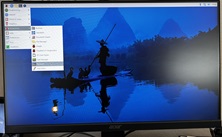 If you haven't already, plug in the power supply, HDMI monitor, keyboard and mouse into the Pi computer. If you are using a CAT5 cable to your router, plug that in as well. Then power up the Pi. It will take 2-3 minutes to boot up and once complete, you will be at the Raspberry Pi OS GUI. If you are using wifi, it should show in the uppper right that you are connected. The upper left will have one or more icons. Hover your mouse pointer on the red raspberry icon. You will see a drop down menu. Click on Accessories and then Terminal. (See image to the left.) This will bring up a terminal window that is reminiscent of Microsoft MS-DOS (remember that?!). This is where you are going to enter the commands to install HamClock.
If you haven't already, plug in the power supply, HDMI monitor, keyboard and mouse into the Pi computer. If you are using a CAT5 cable to your router, plug that in as well. Then power up the Pi. It will take 2-3 minutes to boot up and once complete, you will be at the Raspberry Pi OS GUI. If you are using wifi, it should show in the uppper right that you are connected. The upper left will have one or more icons. Hover your mouse pointer on the red raspberry icon. You will see a drop down menu. Click on Accessories and then Terminal. (See image to the left.) This will bring up a terminal window that is reminiscent of Microsoft MS-DOS (remember that?!). This is where you are going to enter the commands to install HamClock.
On your desktop or laptop, go to https://clearskyinstitute.com/ham/HamClock/. Scroll down a bit and under the screenshot, you will see various tabs. Click on the Desktop tab. Scroll down a bit to where you see "To install HamClock on other UNIX-like systems follow these steps:". Here, you've already done Step 1 on your Pi when you clicked on the raspberry icon and opened a terminal session. Follow Step 2 in that terminal window, entering each line one at a time and pressing ENTER on your keyboard after each line. After you enter the last one, "sudo make install" and press ENTER, your Pi will begin to download the HamClock software and then install it.
When complete, you hopefully got no errors and are ready to go. If you, like me, did see errors reported on the screen, follow the next instructions on the HamClock website, namely "sudo apt-get update" (then press ENTER) and then "sudo apt-get -y install curl make g++ libx11-dev libgpiod-dev" and press ENTER. This will update your Pi OS and various things, and also get a couple of library files required by HamClock.
Now, you should be ready to go. Type "exit" and press ENTER in the terminal window to close it. You should now have a Hamclock icon in the upper left (globe looking thing). Click on that to run it.
On this first running of HamClock, it will prompt you to set some things up, including your call sign, grid square, etc. There are several screens of set up so click through each one, one at a time and configure as you desire. Some fields and pages can be ignored. You can always change the settings later by rebooting and re-entering Setup. When finished configuring, click DONE to save your settings and boot up HamClock.
At this point, you're smiling because you were successful and now have HamClock up and running! But wait. There's more!
At the top of the screen, there are five panels of varying sizes. The left-most has your callsign in it. If you left click on your call (or in the area to the left of your call), you can change the color of the letters in your call. Now left click in the area to the right of your call. This will change the background color around your call.
Now let's modify the next four panels. Left click near the top of each, one at a time. It will bring up a menu of items you can display there. Be sure to click OK after making your selections. If you choose more than one, that panel will rotate through your selections. Modify each panel to your heart's content. And you can change these whenever you like. Rebooting the Pi will not cause them to change back to default. They will remain as you last set them.
You will have a lot of fun learning about the various panel options and the Setup screens, along with other capabilities of this FB software. You can start by clicking on the User Guide tab on the HamClock website on your desktop or laptop. There are also a few YouTube videos out there.
If you get adventurous with your new Pi, you can install and run other software on it. There is a plethora out there, including much ham radio software. You can fool around using this same micro-SD card but what I did was left that one dedicated to HamClock and I use a different micro-SD card for playing around with other ham software. I'm just getting my feet wet with that now.
One more thing. If you look in the upper left-most panel where your callsign is, just below your call is wi-fi strength rotating with the IP address of your Pi. Your router assigned the IP address to the Pi computer and it's likely going to remain static unless you update the firmware of the router. That said, you can use that IP to view your HamClock on any other device in your household using its browser, such as your phone, tablet, desktop or laptop. Just enter that IP address into the browser window! As long as that device is on the same router as your Pi, you'll be able to view the HamClock there. However, you won't be able to click on anything or change the configuration. That needs to be done at the Pi.
You might be asking yourself, "why did NE6I go to the trouble of buying Pi hardware and installing HamClock software when he already owns the Veritium version?" Because I could. Chuckle. No, that wasn't it. I really don't need two HamClocks. I mainly did it for the challenge and also to guide a ham friend who was having trouble with getting his Pi to work with HamClock. If I ever bore of it, I can always sell it or the Veritium but for now, I'm having some fun playing with the new toy.
And I will also leave you with this. There are now Pi 5's on the market though the competition to buy one is fierce. And there are many reports of bugginess so I would suggest sticking with a Pi 4 B for now.
I hope you found this article helpful and entertaining. 73 for now... less
 You'll need a Pi computer. I purchased one from Adafruit. I decided to get the Pi 4 B with 4 GB of RAM (currently $55). WB0OEW tells me the software will run on 1 and 2 GB Pi units, albeit a bit slower. I also purchased their Model 4553 Flirc Aluminum case ($14.95) and Model 5801 Vertical Wall Power Supply ($5.95). (Note, I have not noticed any increase in RF noise or birdies at my QTH with this "wall wart.") It's a 5 VDC supply with a micro-USB connector; something that you possibly have laying around (I didn't). You will also need a micro-HDMI male to HDMI female adapter so that you can connect an HDMI monitor of your choosing into the Pi. I purchased this one on Amazon for five bucks. And you will need a micro-SD card (32 GB is what I used), a micro-SD to SD adapter or a micro-SD to USB adapter for programming it.
You'll need a Pi computer. I purchased one from Adafruit. I decided to get the Pi 4 B with 4 GB of RAM (currently $55). WB0OEW tells me the software will run on 1 and 2 GB Pi units, albeit a bit slower. I also purchased their Model 4553 Flirc Aluminum case ($14.95) and Model 5801 Vertical Wall Power Supply ($5.95). (Note, I have not noticed any increase in RF noise or birdies at my QTH with this "wall wart.") It's a 5 VDC supply with a micro-USB connector; something that you possibly have laying around (I didn't). You will also need a micro-HDMI male to HDMI female adapter so that you can connect an HDMI monitor of your choosing into the Pi. I purchased this one on Amazon for five bucks. And you will need a micro-SD card (32 GB is what I used), a micro-SD to SD adapter or a micro-SD to USB adapter for programming it.
BTW, you can purchase Pi computers, cases, supplies, etc. from several sources including Gigaparts. I just happened to shop at Adafruit which was one of several online shops suggested to me.

Once you have the hardware on hand, install the Pi computer board into the case using the four included screws, and then install the case cover. Before powering up your new Pi, you'll need to install the operating system (OS) onto the micro-SD card. To do so, download the Raspberry Pi Imager software at www.raspberrypi.com/software. I'm a Windows guy, so I downloaded the Windows version. If you are installing on Windows or Mac, ignore the blurb on the webpage about installing Raspberry Pi OS using a Terminal window. If you're going to do it on a Linux box, then yes, you would follow that instruction.
 Now that you have downloaded and installed the Imager, run it. You will have a window like that to the right. Plug your micro-SD card and adapter into your desktop or laptop where you have installed Imager. In Imager, click on CHOOSE DEVICE and select Raspberry Pi 4 (Models B, 400, and Computer Modules 4, 4S). Next click on CHOOSE OS and select Raspberry Pi OS (64 bit). This will give you a GUI on your new Pi. Next click on CHOOSE STORAGE. You will want to be VERY CAREFUL here and select your micro-SD card. I repeat, be very careful to select your micro-SD card!!! If you inadvertently choose your hard drive or SSD or anything other than the micro-SD card and go forth with imaging, you will erase and overwrite everying on that drive! And you will be hating life! So...if you are using a micro-SD card that you had laying around your shack, be sure it doesn't have some important software or data on it because, yes, everything on that card will be erased and overwritten! Fortunately, Imager will give you a warning before proceeding with imaging. Click NEXT.
Now that you have downloaded and installed the Imager, run it. You will have a window like that to the right. Plug your micro-SD card and adapter into your desktop or laptop where you have installed Imager. In Imager, click on CHOOSE DEVICE and select Raspberry Pi 4 (Models B, 400, and Computer Modules 4, 4S). Next click on CHOOSE OS and select Raspberry Pi OS (64 bit). This will give you a GUI on your new Pi. Next click on CHOOSE STORAGE. You will want to be VERY CAREFUL here and select your micro-SD card. I repeat, be very careful to select your micro-SD card!!! If you inadvertently choose your hard drive or SSD or anything other than the micro-SD card and go forth with imaging, you will erase and overwrite everying on that drive! And you will be hating life! So...if you are using a micro-SD card that you had laying around your shack, be sure it doesn't have some important software or data on it because, yes, everything on that card will be erased and overwritten! Fortunately, Imager will give you a warning before proceeding with imaging. Click NEXT.
The next screen will ask "Use OS customisation?" Click on EDIT SETTINGS. On the GENERAL tab, leave Set hostname unchecked. Check the box "Set username and password." You can use whatever username and password you like. I just chose "Pi" as the username and a relatively easy to remember password. If you are desiring to use your wi-fi, check the box for "Configure wireless LAN." Manually type in your wifi SSID. Then type in your wifi password. Select US for "Wireless LAN country." (This selects the correct wifi frequencies here in the USA.) If you are going to use a CAT5 cable to go directly to your router, you can skip this step and leave "Configure wireless LAN" unchecked. Now check the box for "Set locale settings" and choose America/Los_Angeles for the timezone and US for the keyboard layout. On the SERVICES tab, leave Enable SSH unchecked. On the OPTIONS tab, click any you like. Then click SAVE. This takes you back to the "Use OS customization" window. Click on YES.
Here comes your warning that "All existing data on your storage device will be erased. Are you sure you want to continue?" If you are sure it's your micro-SD vard, click YES. If not, click NO and go back to change to the correct device.
If you are using a USB 2.0 adapter, it's going to take 30-45 minutes to write the Raspberry Pi OS to the micro-SD card. So, take a break and go find something else to do for a while. If you are using a USB 3.0 adapter, it will only take a couple of minutes. (See what a difference a $5 USB 3.0 adapter makes?!)
When finished, Imager will let you know that your micro-SD card is ready to go. Best practices tells us to Eject the card using Windows (icon in the lower right of the task tray). I suspect Mac does the same. If you just yank the card out of the USB slot without Ejecting, you could corrupt the Pi OS and have to start over. So yes, save yourself some grief and actually do the Eject first.
Now you are ready to remove the micro-SD card from your adapter and plug it into your Pi computer. You will find the slot on the opposite end from the USB ports on the Pi. BE SURE THE Pi COMPUTER IS POWERED DOWN before inserting the micro-SD card!
 If you haven't already, plug in the power supply, HDMI monitor, keyboard and mouse into the Pi computer. If you are using a CAT5 cable to your router, plug that in as well. Then power up the Pi. It will take 2-3 minutes to boot up and once complete, you will be at the Raspberry Pi OS GUI. If you are using wifi, it should show in the uppper right that you are connected. The upper left will have one or more icons. Hover your mouse pointer on the red raspberry icon. You will see a drop down menu. Click on Accessories and then Terminal. (See image to the left.) This will bring up a terminal window that is reminiscent of Microsoft MS-DOS (remember that?!). This is where you are going to enter the commands to install HamClock.
If you haven't already, plug in the power supply, HDMI monitor, keyboard and mouse into the Pi computer. If you are using a CAT5 cable to your router, plug that in as well. Then power up the Pi. It will take 2-3 minutes to boot up and once complete, you will be at the Raspberry Pi OS GUI. If you are using wifi, it should show in the uppper right that you are connected. The upper left will have one or more icons. Hover your mouse pointer on the red raspberry icon. You will see a drop down menu. Click on Accessories and then Terminal. (See image to the left.) This will bring up a terminal window that is reminiscent of Microsoft MS-DOS (remember that?!). This is where you are going to enter the commands to install HamClock.
On your desktop or laptop, go to https://clearskyinstitute.com/ham/HamClock/. Scroll down a bit and under the screenshot, you will see various tabs. Click on the Desktop tab. Scroll down a bit to where you see "To install HamClock on other UNIX-like systems follow these steps:". Here, you've already done Step 1 on your Pi when you clicked on the raspberry icon and opened a terminal session. Follow Step 2 in that terminal window, entering each line one at a time and pressing ENTER on your keyboard after each line. After you enter the last one, "sudo make install" and press ENTER, your Pi will begin to download the HamClock software and then install it.
When complete, you hopefully got no errors and are ready to go. If you, like me, did see errors reported on the screen, follow the next instructions on the HamClock website, namely "sudo apt-get update" (then press ENTER) and then "sudo apt-get -y install curl make g++ libx11-dev libgpiod-dev" and press ENTER. This will update your Pi OS and various things, and also get a couple of library files required by HamClock.
Now, you should be ready to go. Type "exit" and press ENTER in the terminal window to close it. You should now have a Hamclock icon in the upper left (globe looking thing). Click on that to run it.
On this first running of HamClock, it will prompt you to set some things up, including your call sign, grid square, etc. There are several screens of set up so click through each one, one at a time and configure as you desire. Some fields and pages can be ignored. You can always change the settings later by rebooting and re-entering Setup. When finished configuring, click DONE to save your settings and boot up HamClock.
At this point, you're smiling because you were successful and now have HamClock up and running! But wait. There's more!
At the top of the screen, there are five panels of varying sizes. The left-most has your callsign in it. If you left click on your call (or in the area to the left of your call), you can change the color of the letters in your call. Now left click in the area to the right of your call. This will change the background color around your call.
Now let's modify the next four panels. Left click near the top of each, one at a time. It will bring up a menu of items you can display there. Be sure to click OK after making your selections. If you choose more than one, that panel will rotate through your selections. Modify each panel to your heart's content. And you can change these whenever you like. Rebooting the Pi will not cause them to change back to default. They will remain as you last set them.
You will have a lot of fun learning about the various panel options and the Setup screens, along with other capabilities of this FB software. You can start by clicking on the User Guide tab on the HamClock website on your desktop or laptop. There are also a few YouTube videos out there.
If you get adventurous with your new Pi, you can install and run other software on it. There is a plethora out there, including much ham radio software. You can fool around using this same micro-SD card but what I did was left that one dedicated to HamClock and I use a different micro-SD card for playing around with other ham software. I'm just getting my feet wet with that now.
One more thing. If you look in the upper left-most panel where your callsign is, just below your call is wi-fi strength rotating with the IP address of your Pi. Your router assigned the IP address to the Pi computer and it's likely going to remain static unless you update the firmware of the router. That said, you can use that IP to view your HamClock on any other device in your household using its browser, such as your phone, tablet, desktop or laptop. Just enter that IP address into the browser window! As long as that device is on the same router as your Pi, you'll be able to view the HamClock there. However, you won't be able to click on anything or change the configuration. That needs to be done at the Pi.
You might be asking yourself, "why did NE6I go to the trouble of buying Pi hardware and installing HamClock software when he already owns the Veritium version?" Because I could. Chuckle. No, that wasn't it. I really don't need two HamClocks. I mainly did it for the challenge and also to guide a ham friend who was having trouble with getting his Pi to work with HamClock. If I ever bore of it, I can always sell it or the Veritium but for now, I'm having some fun playing with the new toy.
And I will also leave you with this. There are now Pi 5's on the market though the competition to buy one is fierce. And there are many reports of bugginess so I would suggest sticking with a Pi 4 B for now.
I hope you found this article helpful and entertaining. 73 for now... less
KL7RA CQWW November 2021 by K6ZH
February 2022
2020 California QSO Party Pictures
November 2020
The 55th running of the California QSO Party was October 3 & 4, and the turnout was very high! Axel, KI6RRN appears to have set an all time high score and Marko, N5ZO seems to have broken the Low Power record! Both of them, and many others, were operating as SEQUOIA stations, a new event within CQP this year. SEQUOIA stations used special 1x1 call signs. The last letter represented one of the letters in the word SEQUOIA. If you worked all of the letters, you qualified for a special certificate!
Some SCCC club members sent along pictures of their 2020 CQP operations. Let's take a look.
more
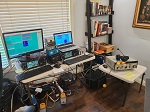
Dan, N6MJ operated as K6E.
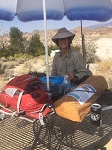
David, N6AN operating field day style at the QTH of Kurt, W6PH. David even used a paper log!

Here is a shot of David's log. Mt. Whitney is in the background (left center). It was a bit hazy here due to the fires in Calif.

Here is Phil, K6MUG and his "sub-eye level antenna" with which he worked 50 Q's and 31 mults.

The next three pictures are of the M/M W6E operations by Scott, N6MI and Paul, W6PNG.
Here is the W6PNG jeep near the inverted vee and hex beam antennas.
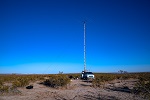
The N6MI station van.
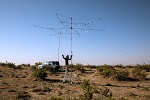
And the hex beam getting some work.
less
Some SCCC club members sent along pictures of their 2020 CQP operations. Let's take a look.
more

Dan, N6MJ operated as K6E.

David, N6AN operating field day style at the QTH of Kurt, W6PH. David even used a paper log!

Here is a shot of David's log. Mt. Whitney is in the background (left center). It was a bit hazy here due to the fires in Calif.

Here is Phil, K6MUG and his "sub-eye level antenna" with which he worked 50 Q's and 31 mults.

The next three pictures are of the M/M W6E operations by Scott, N6MI and Paul, W6PNG.
Here is the W6PNG jeep near the inverted vee and hex beam antennas.

The N6MI station van.

And the hex beam getting some work.
less
6E2T SCCC Team #1 World M/2 1995 ARRL DX CW by N6NC
July 2020

Larry, N6NC tells us about the SCCC effort at 6E2T in Ensenada, Mexico in the 1995 ARRL DX CW contest. The operation took #1 World in the M/2 catgory.
Prelude- 1994 ARRL DX CW
After a SCCC meeting in LA ~JAN 1994, Ken K6LA, Marv K2VIV and I decided to try an operation from MX for the 1994 ARRL DX CW. We rented two side-by-side condos at the then-new Grand Baja Resort complex only yards south of the Puerto Nuevo lobster restaurants.
The landscaping wasn't even finished and there was exposed clay all around the project. Unfortunately we had heavy rains (and snow!) starting on Friday. Ken brought his rig and amp and did all of the operating. Marv and I set up the antennas, I think an A3 tribander on a mast in the courtyard, and a Butternut 160m-40m vertical with 32 wire radials which we set up on the coast road side of the condos. We had coax cables running outside in various places, and if onlookers asked whether we were from CNN, we nodded.
more
The rains grew heavier, and Marv and I were soaked to the skin when unwinding and installing the vertical and placing the 32 radials in the brown MX clay-mud. The vertical required several tuning adjustments throughout the evening, and we got to the point of just stripping off our wet clothes and leaving them in a pile at the condo door ready to put them back on for the next adjustment. At one point the clay mud was so sticky and thick it was like walking around in platform shoes with 6 inches of mud caked on each sneaker.
Ken was a great operator even back then, and ran contacts like crazy. At one point FRI evening with the heavy, salty rain, the ceramic mushroom capacitors on the vertical literally exploded like hand grenades leaving a circle of ceramic shards all around the antenna in the clay mud. Later that night Ken's amp tripped out, having overloaded the condo's circuitry, so we stealthily found and rewired the amp power cord to the next door condo's mains. Then when Ken was out doing some work with one of the antennas he got a painful cactus thorn in his keying thumb, and the project office called the house doctor who came to treat and wrap the injury, so Ken did most of the contest with his keying thumb wrapped in a bandage.
SAT night Marv and I went up to the Rosarito Beach Hotel for dinner while Ken pressed on operating. We were amazed that it had snowed in Rosarito, with 6 inches of snow/frozen sleet on the roads in Rosarito Beach, traffic snarled, and dogs running wild back and forth across the streets like they were mad. Afterward, we called it "The night the dogs went crazy when it snowed in Rosarito." On Sunday Dennis N6KI visited to see what we were doing, and began to warm to the idea of operating from MX. (Dennis and I are Vietnam combat veterans, so these MX operations were a bit of a nostalgic adventure for us.)
I forget how we did in that 1994 ARRL DX CW, but we were beaten by Doug (N6RT) operating at Everett's Rancho Sordo Mundo (School for the Deaf) just north of Ensenada, who had many more 10m contacts than we did. None of the DX stations had done many 160m contacts.
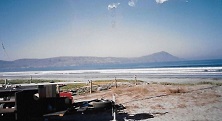 1995 ARRL DX CW
1995 ARRL DX CW
The '94 operation convinced us that we could operate a DX contest from Mexico. The results showed us where we needed more band activity to be successful from Mexico. We discussed a potential 1995 operation amongst some members of SCCC, and Harvey K6QK(SK) and I drove the White Whale (my '89 Ford station wagon) to survey radio sites in Baja that might be more suitable than the Grand Baja Resort.
Harv and I traveled one weekend in northern Baja from San Diego east on Mexico Route 2 to Tecate and the Eagles Nest area, then down through the Guadalupe Valley to Ensenada, and south to the Pta Banda/Pta Estero area. We avoided Rosarito from having already operated there. We surveyed numerous sites on the way, and the best was the sandspit which created the south jaw of the Estero River lagoon south of Ensenada, on the road to the Punta Banda "Blowhole." This site seemed most promising, because we were copying 2 1/2 HF bands at high noon. At each site we used a mast with a single element HF aluminum dipole which we mounted on Harv's base placed under one wheel of the station wagon, with a Kenwood xcvr in the wagon. And we discovered there were several beach houses for rent on the sandspit that separated the Pacific Ocean from the Estero River lagoon.
After we returned, I discussed with Dave K6LL our site survey and the '94 results from the Baja stations, and we decided to try an M/2 Contest DXpedition to Ensenada in FEBR 1995. This required a lot more complex station equipment with three simultaneous CW stations, requiring more antennas, switching, bandpass filters, filter stubs, computers, and generator power for two amplifiers. We actually added a 3d MULT-hunting station to interleave between the two RUN stations, but it was not used much.
I insisted that we do MX licensing properly, unlike some of the other successful gringo MX contest efforts. We made visits to the Tijuana SCT office and met Oscar Rivera, the first lawyer in the MX SCT (their FCC), and the long-time honcho of the Tijuana SCT office. Oscar was very accommodating, assisted us and made sure we were aware of all the specific contest licensing requirements: 51% MX operators shown on the license application; MX /XE2 individual reciprocal licenses; individual tourist visas; special detailed contest permit requirements-- we could only gain a Class II MX license [500w] because our MX sponsors were not senior enough; special contest callsign requirements; understanding MX law re permit issuance; MX Federal pre-emption law re SCT permits trumping environmental regulations-- the tip of the Punta Estero southern jaw was an MX National Bird Sanctuary, and the house we rented was close to it.
We accomplished all this required legal detail for K6LA, K6LL, N6HC, N6NC, N6KI and KM6SN well in advance of the 1995 ARRL DX CW, and N6KI arranged the rental of a beach house near the narrow tip of the sandspit where there was effectively a salt water ground plane below because of the Pacific Ocean on one side and the brackish Estero River lagoon on the other side. The bonus was the empty lot at the north side of the beach house which we used to set up our antennas and towers.
There were more complicated equipment requirements for M/2-- filters, amps, towers, antennas and generators for three stations. Dennis N6KI had run the technical side of the Palomar Club's Field Day events, sometimes running up to 27 transmitters, so he undertook responsibility for all the technical aspects of our contest DXpedition set-up. We borrowed Harv K6QK's 40ft tower trailer, and I outfitted the White Whale station wagon for towing with a hitch and heavy duty adjustable "air bag" shock absorbers for the rear. We purchased two 2000w quiet Honda generators to run the amps, two Dunestar bandpass filters, two 49ft military push-up section towers from the fellow at Visalia who used to sell surplus gear around the pool there. We bought two used AL-80 500w 3-500Z amps (per CLASS II MX license), desktop computers, monitors and UPCs for the CT logging software. We built filter stubs for the bands, and we had tested every piece of equipment in San Diego before heading off to Ensenada for the 1995 ARRL DX CW on the THURS before the contest.
On the trip down, we discovered at the border that we needed a special US Customs form to bring all this gear into MX and then bring it out without paying duty, which required an inventory of every piece of gear including model and serial number, so that took some time. We arrived at the beach house in partly cloudy but clearing weather, and began setting up-- some members assigned to shack setup, wiring and testing, others to tower and antenna setup.
In the adjacent empty lot covered with sand dunes and scrub, we set up Harv's 40ft crank-up tower trailer with his TET tribander and the two 49ft mil towers section by section. One held Ken's A3 tribander, the other held Harv's 80/40m fan dipole (hung as an inverted V) and the far end of the 160m inverted L. (We had no DX cluster back then.)
For 160m, Red W6AE had told me vociferously after a couple of beers at Visalia-- "132 feet! That's all you need, a 132ft wire for 160m." So to create a 160m inverted L we ran a short length of coax out the window from the shack to an old Unique Single Wire tuner I had picked up at a swap meet, with a 4ft ground rod planted right next to it, ran the antenna wire vertically 14ft to the roof eave, then at a long, flat angle to the top of one 49ft tower, and laid a 132ft radial on the ground under the horizontal portion of the L.
For 80m and 40m we used Harv's fan dipole, and added stubs to the ends to resonate in the CW portions of the bands. The two tri-banders served one each station for 20-15-10m.
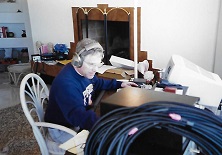
We tested everything and had it all working by mid-day FRI. We organized into three watch sections of two ops each for 4 hour watches. Dave K6LL and Ken K6LA opened and had combined CW rates of over 600 Qs/hr. Arnie N6HC and I had the 2d watch and had combined rates of over 300 Qs/hr. I had the 160m station when that band opened on FRI night and to this day I have never heard pile-ups as heavy as we encountered on 160m with Red's "132ft" inverted L. Dennis N6KI and Rod KM6SN did equally well in their 3d watch from midnight. We had brass MULT bells for each station and they were great for morale, even at 3am when two teams were trying to sleep.
Our only serious interruptions were from the president of the Punta Estero HO Ass'n (can you believe it?) and the Chief of the local Federales, who demanded to see our permits, and was astonished everything was in order, and that we had prepared full copies for them to keep for their files. We banged CW all night both nights, all day on SAT, and on SUN till close of the contest, when exhausted, we just turned everything off and went to dinner at a small fish restaurant we found open on the winding road to the Punta Banda Blowhole.
On MON we spent the day taking everything down, and suddenly noticed how beautiful the site was with panoramic views of Ensenada Bay, Todos Santos Island and the hills north of Ensenada. We had been too focused on the mission to notice and appreciate that until the end of the operation.
We knew we had done a creditable effort, and most importantly, everything worked great due to our planning and testing. About mid-week after, Dave K6LL emailed me and reported we had done very well amongst the DX M/2 stations who reported on 3830 or internet, and in fact, might have won WORLD 1st Place DX M/2 category with our 5200+ Qs, which turned out to be the case. Reviewing the line scores, we were neck and neck with the other DX M/2 stations on 80m through 20m, but we killed them on 160m and 10m to give us the victory (thanks Red W6AE!). (And I'll always remember than David N6AN, operating from his apartment house in MX City did ~5000Qs single op in that same contest!)
Anyway, folks, that's the saga of the SCCC contest station that won the WORLD 1st Place, DX M/2 from Ensenada MX in the 1995 ARRL DX CW Contest.
73, Larry N6NC
less
Ken was a great operator even back then, and ran contacts like crazy. At one point FRI evening with the heavy, salty rain, the ceramic mushroom capacitors on the vertical literally exploded like hand grenades leaving a circle of ceramic shards all around the antenna in the clay mud. Later that night Ken's amp tripped out, having overloaded the condo's circuitry, so we stealthily found and rewired the amp power cord to the next door condo's mains. Then when Ken was out doing some work with one of the antennas he got a painful cactus thorn in his keying thumb, and the project office called the house doctor who came to treat and wrap the injury, so Ken did most of the contest with his keying thumb wrapped in a bandage.
SAT night Marv and I went up to the Rosarito Beach Hotel for dinner while Ken pressed on operating. We were amazed that it had snowed in Rosarito, with 6 inches of snow/frozen sleet on the roads in Rosarito Beach, traffic snarled, and dogs running wild back and forth across the streets like they were mad. Afterward, we called it "The night the dogs went crazy when it snowed in Rosarito." On Sunday Dennis N6KI visited to see what we were doing, and began to warm to the idea of operating from MX. (Dennis and I are Vietnam combat veterans, so these MX operations were a bit of a nostalgic adventure for us.)
I forget how we did in that 1994 ARRL DX CW, but we were beaten by Doug (N6RT) operating at Everett's Rancho Sordo Mundo (School for the Deaf) just north of Ensenada, who had many more 10m contacts than we did. None of the DX stations had done many 160m contacts.
 1995 ARRL DX CW
1995 ARRL DX CW
The '94 operation convinced us that we could operate a DX contest from Mexico. The results showed us where we needed more band activity to be successful from Mexico. We discussed a potential 1995 operation amongst some members of SCCC, and Harvey K6QK(SK) and I drove the White Whale (my '89 Ford station wagon) to survey radio sites in Baja that might be more suitable than the Grand Baja Resort.
Harv and I traveled one weekend in northern Baja from San Diego east on Mexico Route 2 to Tecate and the Eagles Nest area, then down through the Guadalupe Valley to Ensenada, and south to the Pta Banda/Pta Estero area. We avoided Rosarito from having already operated there. We surveyed numerous sites on the way, and the best was the sandspit which created the south jaw of the Estero River lagoon south of Ensenada, on the road to the Punta Banda "Blowhole." This site seemed most promising, because we were copying 2 1/2 HF bands at high noon. At each site we used a mast with a single element HF aluminum dipole which we mounted on Harv's base placed under one wheel of the station wagon, with a Kenwood xcvr in the wagon. And we discovered there were several beach houses for rent on the sandspit that separated the Pacific Ocean from the Estero River lagoon.
After we returned, I discussed with Dave K6LL our site survey and the '94 results from the Baja stations, and we decided to try an M/2 Contest DXpedition to Ensenada in FEBR 1995. This required a lot more complex station equipment with three simultaneous CW stations, requiring more antennas, switching, bandpass filters, filter stubs, computers, and generator power for two amplifiers. We actually added a 3d MULT-hunting station to interleave between the two RUN stations, but it was not used much.
I insisted that we do MX licensing properly, unlike some of the other successful gringo MX contest efforts. We made visits to the Tijuana SCT office and met Oscar Rivera, the first lawyer in the MX SCT (their FCC), and the long-time honcho of the Tijuana SCT office. Oscar was very accommodating, assisted us and made sure we were aware of all the specific contest licensing requirements: 51% MX operators shown on the license application; MX /XE2 individual reciprocal licenses; individual tourist visas; special detailed contest permit requirements-- we could only gain a Class II MX license [500w] because our MX sponsors were not senior enough; special contest callsign requirements; understanding MX law re permit issuance; MX Federal pre-emption law re SCT permits trumping environmental regulations-- the tip of the Punta Estero southern jaw was an MX National Bird Sanctuary, and the house we rented was close to it.
We accomplished all this required legal detail for K6LA, K6LL, N6HC, N6NC, N6KI and KM6SN well in advance of the 1995 ARRL DX CW, and N6KI arranged the rental of a beach house near the narrow tip of the sandspit where there was effectively a salt water ground plane below because of the Pacific Ocean on one side and the brackish Estero River lagoon on the other side. The bonus was the empty lot at the north side of the beach house which we used to set up our antennas and towers.
There were more complicated equipment requirements for M/2-- filters, amps, towers, antennas and generators for three stations. Dennis N6KI had run the technical side of the Palomar Club's Field Day events, sometimes running up to 27 transmitters, so he undertook responsibility for all the technical aspects of our contest DXpedition set-up. We borrowed Harv K6QK's 40ft tower trailer, and I outfitted the White Whale station wagon for towing with a hitch and heavy duty adjustable "air bag" shock absorbers for the rear. We purchased two 2000w quiet Honda generators to run the amps, two Dunestar bandpass filters, two 49ft military push-up section towers from the fellow at Visalia who used to sell surplus gear around the pool there. We bought two used AL-80 500w 3-500Z amps (per CLASS II MX license), desktop computers, monitors and UPCs for the CT logging software. We built filter stubs for the bands, and we had tested every piece of equipment in San Diego before heading off to Ensenada for the 1995 ARRL DX CW on the THURS before the contest.
On the trip down, we discovered at the border that we needed a special US Customs form to bring all this gear into MX and then bring it out without paying duty, which required an inventory of every piece of gear including model and serial number, so that took some time. We arrived at the beach house in partly cloudy but clearing weather, and began setting up-- some members assigned to shack setup, wiring and testing, others to tower and antenna setup.
In the adjacent empty lot covered with sand dunes and scrub, we set up Harv's 40ft crank-up tower trailer with his TET tribander and the two 49ft mil towers section by section. One held Ken's A3 tribander, the other held Harv's 80/40m fan dipole (hung as an inverted V) and the far end of the 160m inverted L. (We had no DX cluster back then.)
For 160m, Red W6AE had told me vociferously after a couple of beers at Visalia-- "132 feet! That's all you need, a 132ft wire for 160m." So to create a 160m inverted L we ran a short length of coax out the window from the shack to an old Unique Single Wire tuner I had picked up at a swap meet, with a 4ft ground rod planted right next to it, ran the antenna wire vertically 14ft to the roof eave, then at a long, flat angle to the top of one 49ft tower, and laid a 132ft radial on the ground under the horizontal portion of the L.
For 80m and 40m we used Harv's fan dipole, and added stubs to the ends to resonate in the CW portions of the bands. The two tri-banders served one each station for 20-15-10m.

We tested everything and had it all working by mid-day FRI. We organized into three watch sections of two ops each for 4 hour watches. Dave K6LL and Ken K6LA opened and had combined CW rates of over 600 Qs/hr. Arnie N6HC and I had the 2d watch and had combined rates of over 300 Qs/hr. I had the 160m station when that band opened on FRI night and to this day I have never heard pile-ups as heavy as we encountered on 160m with Red's "132ft" inverted L. Dennis N6KI and Rod KM6SN did equally well in their 3d watch from midnight. We had brass MULT bells for each station and they were great for morale, even at 3am when two teams were trying to sleep.
Our only serious interruptions were from the president of the Punta Estero HO Ass'n (can you believe it?) and the Chief of the local Federales, who demanded to see our permits, and was astonished everything was in order, and that we had prepared full copies for them to keep for their files. We banged CW all night both nights, all day on SAT, and on SUN till close of the contest, when exhausted, we just turned everything off and went to dinner at a small fish restaurant we found open on the winding road to the Punta Banda Blowhole.
On MON we spent the day taking everything down, and suddenly noticed how beautiful the site was with panoramic views of Ensenada Bay, Todos Santos Island and the hills north of Ensenada. We had been too focused on the mission to notice and appreciate that until the end of the operation.
We knew we had done a creditable effort, and most importantly, everything worked great due to our planning and testing. About mid-week after, Dave K6LL emailed me and reported we had done very well amongst the DX M/2 stations who reported on 3830 or internet, and in fact, might have won WORLD 1st Place DX M/2 category with our 5200+ Qs, which turned out to be the case. Reviewing the line scores, we were neck and neck with the other DX M/2 stations on 80m through 20m, but we killed them on 160m and 10m to give us the victory (thanks Red W6AE!). (And I'll always remember than David N6AN, operating from his apartment house in MX City did ~5000Qs single op in that same contest!)
Anyway, folks, that's the saga of the SCCC contest station that won the WORLD 1st Place, DX M/2 from Ensenada MX in the 1995 ARRL DX CW Contest.
73, Larry N6NC
less
Veritium HFClock Review by NE6I
April 2020
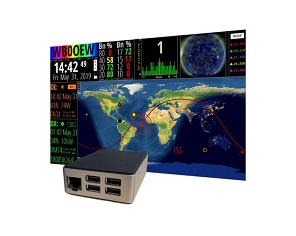 Contesters and DXers alike are well aware that propagation is often enhanced considerably to and from an area in the world where it is sunrise or sunset, something we call gray line. Way back in the days before computers, a company named Xantek manufactured a product called "The DX Edge." This wonderful tool consisted of a series of plastic slides, one for each month, that slid back and forth through a "carrier," or flat Mercator map of the world. This simulated the earth's rotation, and allowed us to see which parts of the world were in daylight, which were in darkness, and most importantly, which were in the gray line. It was an ingenious creation and was quite popular in its time. See picture below.
Contesters and DXers alike are well aware that propagation is often enhanced considerably to and from an area in the world where it is sunrise or sunset, something we call gray line. Way back in the days before computers, a company named Xantek manufactured a product called "The DX Edge." This wonderful tool consisted of a series of plastic slides, one for each month, that slid back and forth through a "carrier," or flat Mercator map of the world. This simulated the earth's rotation, and allowed us to see which parts of the world were in daylight, which were in darkness, and most importantly, which were in the gray line. It was an ingenious creation and was quite popular in its time. See picture below.
Fast forward to today, and we have computers and software to do this for us. There is even a small version of this included in the popular N1MM+ contesting software.
more
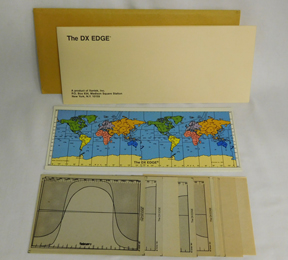 Perhaps one of the more well known products now on the market is the Geochron World Clock and their Digital 4K version. They are beautiful devices and quite functional.
Perhaps one of the more well known products now on the market is the Geochron World Clock and their Digital 4K version. They are beautiful devices and quite functional.
The new kid on the block is the Veritium HFClock, manufactured by Veritium Research. Veritium's primary business is medical equipment but the engineers are hams, and they created the HFClock as a side project. They released it to the market about a year ago, and it has evolved steadily since then through approximately monthly software updates.
The HFClock is much more than a clock. Most of the screen space is occupied by the Mercado map with daylight and darkness shown. And it doesn't end there. The Clock comes in a few different desktop models with frame as well as a Raspberry Pi version that connects to the user's own external monitor. These Clocks are currently available exclusively through Gigaparts.
It was this latter version (Model 1850-RP) that caught my attention. I was interested in running it to a large monitor hanging above my ham station.
Mine arrived quickly and I set about to get it operational. Unfortunately, the one I received was running a little older version of software and the short and sweet quick start flyer did not match the software on the unit.
The first step upon booting the unit up is to connect to the internet, either wired to your modem or router, or via wi-fi. I chose the latter since my router is across the room from my ham station where the HFClock was going to reside. I made three attempts to connect to my wi-fi but was met with failure each time. The Clock told me an invalid username or password had been entered. There is only one user review at the Gigaparts site as I write this, and he too could not get wi-fi working. I reached out to WB0OEW because it appeared to me (thanks to our world wide web) that he was the creator of this device. Within an hour, he responded but asked me to contact Veritium support. Per his agreement with them, they handle all inquiries related to this product.
So I did. Veritium is in New Jersey and it was now well past their closing time. Never-the-less, a response came back from Gino Morello, N2TBN within minutes. He happened to be at home and saw the email come in. He inquired as to which model I had. I sent my answer back and headed to dinner. His response came back quickly but I did not have a chance to see it until the following morning.
Gino recommended that I temporarily connect the Clock via CAT5 to my router, boot up, and select YES to udpate to the latest firmware. I was then to power off and disconnect the CAT5 cable, then power the unit back up and go into Setup. Then enter my wi-fi info. He told me he would be in the office and provided his direct telephone number.
His instructions worked perfectly and my new Clock connected to the wi-fi router without issue. I decided to call Gino anyway and ask him to quickly walk me through the many onscreen options. He was more than happy to do so, and in fact, I could tell how excited he was about this product! He sounded like a kid in a candy store!
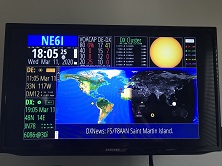 As you can see in the photos, you can enter your call sign (we hams are vain son of a guns, aren't we?) and your grid indicator. Naturally, you can change the font color and background color of your call sign to something that you prefer. The clock connects to an NTP server via the internet for very accurate time. UTC time is displayed in the upper left and your local time down lower on the left side. You can elect to turn off NTP and manually change UTC time to whatever you like, allowing you to see daylight and darkness areas at that time of day. Nifty!
As you can see in the photos, you can enter your call sign (we hams are vain son of a guns, aren't we?) and your grid indicator. Naturally, you can change the font color and background color of your call sign to something that you prefer. The clock connects to an NTP server via the internet for very accurate time. UTC time is displayed in the upper left and your local time down lower on the left side. You can elect to turn off NTP and manually change UTC time to whatever you like, allowing you to see daylight and darkness areas at that time of day. Nifty!
You can click anywhere on the map and see information related to that location (displayed in the lower left where it says "DX." That box will include distance from your QTH and beam heading. You can click on the heading line and toggle between short path and long path headings.
The box to the right of your call sign can toggle between VOACAP info (MUF and LUF), sunspot numbers, and solar flux. The next box over along the top can display a DX Cluster, Planetary KP, or GOES 15 Xray information. I had some trouble getting it to connect to several clusters but finally found one that worked. I don't find that display particularly useful because there is no way (that I know of) to set filters, but it's an entertaining piece of the display. It may be that if one logs into the cluster via the web or a cluster client, sets the filters, then connects via the HFClock, the filters may work. I haven't had a chance to try this just yet. I should mention that you can click on any displayed call sign in the DX Cluster window to instantly see information about that location in the DX window in the lower left.
To the right of that box is a display of the sun. The user can toggle through several options there as well. Composite, Magnetogram, and 6173A related to the Solar Dynamic Observatory are the options.
The upper right corner of the display shows the NCDXF beacon key. Clicking on this box toggles display of those beacons on the Mercado map. There is also an option to turn your display on and off at times you specify within this box. This, like most other things in this product, was suggested by a user. His display was in a room where he wanted it to automatically turn on and off at times he desired without any interaction on his part.
By the way, the windows on the left side of the screen (DE and DX) also show sunrise and sunset times for you and the DX location you have clicked on.
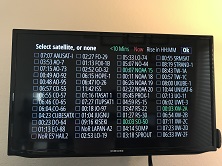
The user can click on the letters "DX" in that lower lefthand pane to bring up a list of satellites. You may select any one of them to display tracking information on the Mercado map in real time. During my call with Gino, we looked at a couple of them together. Ironically, the International Space Station (ISS) was flying overhead above my QTH, and we watched it pass through the window showing potential reception at my location (also displayed on the map). Very cool! Gino tells me that the user may edit the satellite list and RSS feed sources (described below) by tunneling into the HFClock using SSH (IE, via Putty or similar software) from another PC elsewhere on your network.
In the very lower left of the Mercado map, you will see a small box that says "RSS." Clicking on that toggles a news feed along the bottom of the map. The user can click on any news item to get the full story on that headline. As I type this, I am seeing some DX news (including the recent VP8PJ DXpedition).
The unit itself is very small, about the size of a pack of playing cards. I was happy about that because I don't have a lot of room on my desk. It does have four USB ports (in addition to the port for CAT5). I use a wireless mouse to click around on the display. I used a wired keyboard in my first attempt to do wi-fi set up but this is not required as the unit displays a screen keyboard that can be used in conjunction with the mouse to enter text. The unit does run a bit on the warm side so I recommend taking that into account when deciding where to place it. It should be able to be placed on the back side of your monitor using Velcro or something similar if desired. Video out to the monitor is via an HDMI cable (not included).
Gino tells me that coming soon is the ability to control certain models of antenna rotator by simply clicking on the map (and I presume a DX spot)!
I must say, I am really enjoying this HFClock, and I found Gino's enthusiam exciting. He told me more than once that if I had any suggestions for further improvement or display options to please let him know. The product's evolution has been driven by user feedback! I have mine connected to a 32 inch display hanging on the wall above my station. You are limited in this regard only by your creativity.
The manual for the unit can be found on Veritium Research's web site, and a couple of videos can be found on YouTube.
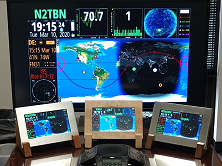
Kudos to Veritium for a very fine line of products! Click here for more information about their clocks, and remember, Gigaparts is the current U.S. distributor.
less
The Other Side of the World by N6VI
January 2020
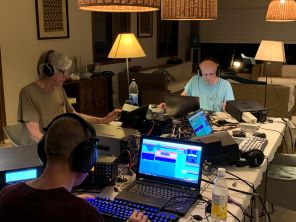 CQWW DX CW From 3B8 by Marty Woll, N6VI
CQWW DX CW From 3B8 by Marty Woll, N6VI
Many of us have had the chance to operate DX contests from outside the Lower 48, but how far from home can you get, really? The answer, of course, is about 12,000 miles - yes, the other side of the globe! I had the chance to do just that last month (November).
The adventure began when Olof G0CKV started assembling a team to operate the CQ Worldwide CW contest from the island of Mauritius, which lies east of Madagascar in the Indian Ocean. Dick N6AA got an invitation for himself and Art W6XD from Olof, but the team size was limited by the expected number of operating positions and the number of people the location could house. As some of the original participants dropped out, room opened up for another, and I was pleased to fill that spot. The final team consisted of Olof, Dick, Art, me, Denny KX7M from Northern California and past ARRL CEO Dave K1ZZ.
more
Shown in the picture above are Denny, KX7M (dark shirt, back to the camera), Dick, N6AA (top left) and Dave, K1ZZ (top right, blue shirt).
Olof was no stranger to operating from this part of the world, having activated both Mauritius and Rodrigues multiple times in the past. He and his wife had also vacationed frequently at L'Ilot, a spacious, comfortable home on a small man-made peninsula on the northeast coast with roughly 300 compass degrees of salt water shoreline. This time he put the lovely vacation spot and the radio exploits together, and L'Ilot's ocean-facing veranda became our station location. As a bonus, our rent included the services of two very nice local ladies who cooked delicious meals for us and cleaned up every day.
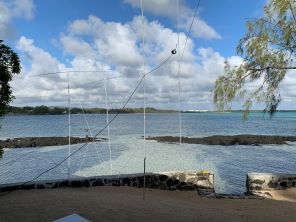
Olof brought ground-plane verticals for 40, 80 and 160 meters built using Spider Beam fiberglass masts and wires; they went up fairly easily and performed very well. I brought a golf-club case loaded with aluminum vertical dipole arrays for 20, 15 and 10 meters. Within two days all the antennas and feedlines were in place with coax running to a large table at the center of the veranda. Each of three stations included an Elecraft K3 and a solid-state amplifier (two SPE's and a THPL), and a fourth K3 ran barefoot. All four positions had WinTest logging, and combinations of bandpass filters and stub filters helped minimize interference between stations. Keeping the RF out of the computers was actually one of the toughest challenges; Denny put his IT skills and Olof's supply of ferrites to work to resolve those problems.
We all spent time on the bands in the days before the contest, making note of likely opening and closing times as we formulated an operating plan. Although our location was surprisingly quiet, we found significant atmospheric noise, most likely from thunderstorms in the regions of Indonesia to the east and central Africa to the west. We sometimes needed multiple repeats to get a call sign right because a crash would take out one or more characters.
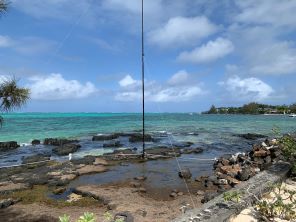
The contest itself went smoothly, with no hardware crises and sufficient operating time for all of us. We logged over 8,600 contacts, 175 band-zones and 570 band-countries for a raw score of just over 19 million points. Considering how far we were from the heavily populated parts of the world and where we are in the solar cycle, we were happy with that result. I was pleased at how well the personalities and skills of the team members blended. Everyone pitched in willingly to do whatever work was needed, and spirits were high throughout our stay.
less
Olof was no stranger to operating from this part of the world, having activated both Mauritius and Rodrigues multiple times in the past. He and his wife had also vacationed frequently at L'Ilot, a spacious, comfortable home on a small man-made peninsula on the northeast coast with roughly 300 compass degrees of salt water shoreline. This time he put the lovely vacation spot and the radio exploits together, and L'Ilot's ocean-facing veranda became our station location. As a bonus, our rent included the services of two very nice local ladies who cooked delicious meals for us and cleaned up every day.

Olof brought ground-plane verticals for 40, 80 and 160 meters built using Spider Beam fiberglass masts and wires; they went up fairly easily and performed very well. I brought a golf-club case loaded with aluminum vertical dipole arrays for 20, 15 and 10 meters. Within two days all the antennas and feedlines were in place with coax running to a large table at the center of the veranda. Each of three stations included an Elecraft K3 and a solid-state amplifier (two SPE's and a THPL), and a fourth K3 ran barefoot. All four positions had WinTest logging, and combinations of bandpass filters and stub filters helped minimize interference between stations. Keeping the RF out of the computers was actually one of the toughest challenges; Denny put his IT skills and Olof's supply of ferrites to work to resolve those problems.
We all spent time on the bands in the days before the contest, making note of likely opening and closing times as we formulated an operating plan. Although our location was surprisingly quiet, we found significant atmospheric noise, most likely from thunderstorms in the regions of Indonesia to the east and central Africa to the west. We sometimes needed multiple repeats to get a call sign right because a crash would take out one or more characters.

The contest itself went smoothly, with no hardware crises and sufficient operating time for all of us. We logged over 8,600 contacts, 175 band-zones and 570 band-countries for a raw score of just over 19 million points. Considering how far we were from the heavily populated parts of the world and where we are in the solar cycle, we were happy with that result. I was pleased at how well the personalities and skills of the team members blended. Everyone pitched in willingly to do whatever work was needed, and spirits were high throughout our stay.
less
N6NB - Contesting For 61 Years
November 2018
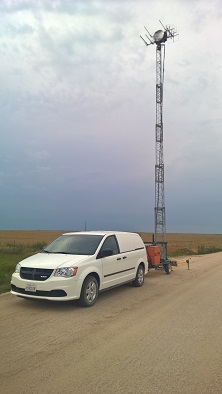 Wayne Overbeck is no stranger to SCCCers. He has been contesting for 61 years! That's longer than some of us have been alive! His tower trailers have also been used for SCCC contesting (think XE2SI in the 1980s for example.) His web site is chalk full of contest and other good stuff. I asked Wayne to tell us a little about his VHF and up roving activities and was honored to get his story below.
Wayne Overbeck is no stranger to SCCCers. He has been contesting for 61 years! That's longer than some of us have been alive! His tower trailers have also been used for SCCC contesting (think XE2SI in the 1980s for example.) His web site is chalk full of contest and other good stuff. I asked Wayne to tell us a little about his VHF and up roving activities and was honored to get his story below.
I've been on the air for 61 years now. I've been operating VHF contests for almost that long, but I didn't manage to win a VHF contest nationally for a lot of years. It's never been easy to be competitive in VHF contests in the west. I finally reached #1 in the single operator category in June, 1973. Then I was #1 in five June contests in a row (1973-1977). After a year with almost no sporadic E here but excellent E skip in the east in 1978, I took a van and tower trailer to the northeast in 1979. I ended up winning 12 VHF contests nationally as a single operator before ARRL section multipliers were replaced by grid square multipliers in 1984.
more
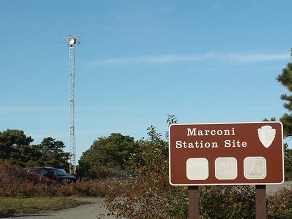 In the grid square era, I operated mostly in the new rover and single
operator portable categories. By now I've had the #1 rover score
nationally in 23 VHF-UHF contests and seven #1 scores in SOP.
Along the way I organized rover groups that had high enough scores
to help SCCC win 13 gavels for the #1 medium club score in VHF
contests. I also had the highest rover score nationally in the
first two ARRL 222 and Up Distance Contests.
In the grid square era, I operated mostly in the new rover and single
operator portable categories. By now I've had the #1 rover score
nationally in 23 VHF-UHF contests and seven #1 scores in SOP.
Along the way I organized rover groups that had high enough scores
to help SCCC win 13 gavels for the #1 medium club score in VHF
contests. I also had the highest rover score nationally in the
first two ARRL 222 and Up Distance Contests.
However, my days of roving are just about over. Mobility is a problem now and my 10-band "toolbox" stations are getting heavier every year than they were the last time I lifted one onto a car rooftop. Maybe it's time for me to concentrate on cruising around on a mobility scooter when I want to go "roving."
73, Wayne, N6NB
Thank you, Wayne. We hope you will consider continuing to rove, perhaps enlisting a partner to go with you.
less
I Wanna Take You Higher by N6VI
May 2018
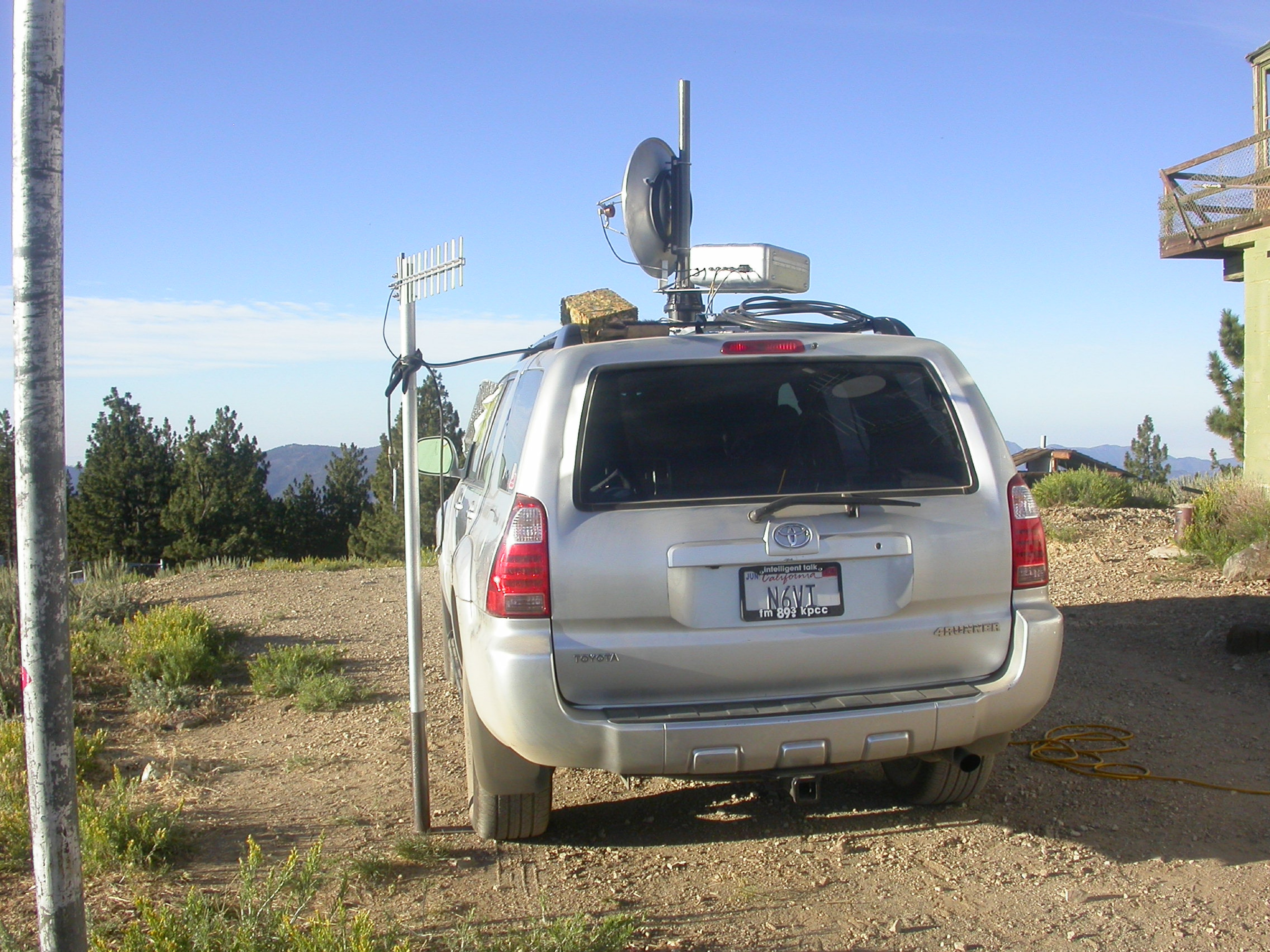 I Wanna Take You Higher (Boom Shaka Laka Laka)
I Wanna Take You Higher (Boom Shaka Laka Laka)
So, ten meters isn't open to anywhere. What to do? HF'ers will say, "Go lower", but I did the opposite. I went higher - much higher - to 10 gigahertz, a.k.a. the 3 cm band.
The first weekend in May is the 2 GHz & Up contest, sponsored by the San Bernardino Microwave Society, so I took a 24" dish with a 2-Watt transverter up to Frazier Peak and spent the day. Like its HF counterpart, conditions on 10 GHz were not very good this weekend, but I managed over two dozen contacts with distances up to nearly 600 km. Just as on HF, when conditions are not good enough for SSB, I went to CW for several of the more distant contacts, and that did the trick.
more
Over the past several years, I have made X-band contacts into Nevada and Arizona as well as up to Mt. Shasta in Northern California with this same basic set-up. One recently announced operating award has raised the interest of HF'ers in (Maidenhead System) grid squares, but VHF / UHF / microwave have been chasing them for decades. This past weekend brought my 3 cm grid square total up to 19.
Any of you who have had the opportunity to work with one of N6NB's loaner rover stations have had a taste of what the microwave bands can do. So, while you're waiting for sunspots to return . . .
Marty N6VI
less
HH2AA Remote Operation in ARRL DX Phone by W2GD
March 2018
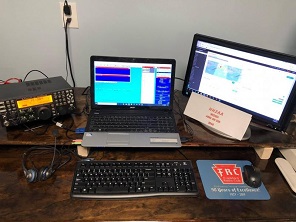 Even after five decades of contesting, there is always something new to
try. My first attempt at remote operation turned out to be an amazing and unique
adventure. My tale below is rather long - there were so many twists and turns.
Even after five decades of contesting, there is always something new to
try. My first attempt at remote operation turned out to be an amazing and unique
adventure. My tale below is rather long - there were so many twists and turns.
First a few words about HH2AA, a station that has been on the Remote Ham Radio (RHR) network for a few years. This is a proof of concept project supported by RHR in cooperation with the Radio Club of Haiti. All proceeds from station rentals are returned to the people of Haiti through donations to the Haiti Air Ambulance Service organization - https://www.haitiairambulance.org. The station is a test platform used to try out off shore construction and operation techniques. It is located on a mountain at 6,300 feet ASL near Port-au-Prince, Haiti, solar powered, and remotely controlled using proprietary RHR software.
more
Station assets include an Elecraft K3 running up to 100w, a Cushcraft A3 tribander fixed NW (USA/JA), a Cushcraft A4 fixed NE (EU), and a 160M OCF wire antenna. All antennas are mounted on a Rohn 45G 80 foot tower. A rotatable mulit-band antenna is planned in coming months. There is fiberoptic internet service to the site. All HH2AA contacts are uploaded to LOTW almost immediately and QSL cards can requested from NR6M. The grid square is FK38uk.
Pictures and additional information about the station can be found at these URLs:
https://www.qrz.com/db/hh2aa and
http://www.remotehamradio.com/2017/04/hh2aa-is-back/ and
http://www.remotehamradio.com/2017/12/hh2aa/
I sincerely thank the owners of RHR for providing this unique opportunity to test drive HH2AA during the 2018 ARRL DX Phone contest. The original plan was to set the station up at the site of my own future 'remote' at KU2C/3 in Finland, PA. As you will read below adapting to rapidly changing circumstances can be an important part of this game we call contesting.
Timeline of Events Leading Up to Operating HH2AA:
Tuesday 2/21 Received the green light from RHR to use HH2AA during the ARRLDX Phone Contest.
Wednesday 2/22 Determined my 15 year old Dell laptop lacks the necessary horsepower to handle the task.
Saturday 2/24 KU2C comes up with a more powerful laptop and extra monitor (Thanks Pete!)
Tuesday 2/27 Lee, WW2DX at RHR and Pete, KU2C run proof of concept tests - everything works!
Thursday 3/1 Set station up at KU2C's QTH using my K3S. Test several microphones. Dial in the VOX settings. Integrate Win-Test. Everything is ready to go! My K3S and Win-Test control the K3 at HH2AA perfectly. Make 100 contacts to get the feel for remote operation. Leave KU2C that evening feeling totally upbeat.
Friday 3/2 10:30 a.m. Impact of a predicted major coastal storm begins to be felt by mid-morning. Snow and high winds start to make travel by automobile difficult.
3/2 11:59 a.m. KU2C sends a text to tell me he's lost commercial power due to downed trees. Estimated time to repair unknown (repairs were not made until late Sunday afternoon). Concurrently, while on the FRC Slack Chat Channel, developed a Plan B - I'll travel the 37 miles to KU2C, pick up station, and relocate to K3WW who has emergency power and internet.
3/2 2:30 p.m. Set off on the trek to KU2C/3 allowing several extra hours for possible travel difficulties. My projected ETA is 5 p.m.
3/2 5:35 p.m. Lee at RHR calls to tell me connectivity to HH2AA has been lost. It is a local Internet Service Provider (ISP) problem on Haiti. Tech will visit site in the morning. We discuss possible operation using another RHR site within FRC club territory until fate of HH2AA is known.
3/2 6:30 p.m. Have now been on the road for four hours and advanced just 25 miles. Have seen over a dozen cars and school buses off the road, many snapped utility poles, downed power lines, uprooted trees, experienced blizzard whiteout conditions, and most importantly have yet to find a plowed or treated road surface. Traffic is at a total standstill in the area of Perkesie, PA. Routes 313 and 113 are parking lots.
3/2 6:40 to 7:10 p.m. Take refuge in a restaurant and have dinner. Nothing is going well as you can tell.
3/2 7:15 p.m. Back on the road. Finally find a way to get beyond a major hill that has prevented me from reaching KU2C, only to be detoured again twice by downed trees and wires.
3/2 9:30 p.m. After seven hours finally reach KU2C in Finland, PA. We load the station into my car and I set off for K3WW. Immediately encounter another blocked road - tree down. Will this horror show ever end?
3/2 10:25 p.m. Reach K3WW. Driveway is blocked by nearly three feet of piled up snow. Call RHR. All NY stations are now off the network due to storm related problems (no power, no internet, etc.) Decide to drive home to NJ. You can't fight mother nature.
3/2 11:55 p.m. Arrive home after over 9+ hours of travel. Road conditions magically improved as I crossed the bridge between PA into NJ. Contemplate what to do in the morning.
Saturday 3/3 9:00 a.m. Talk to Lee at RHR. Technician has been dispatched by ISP to diagnose problem. ETA on-site is unknown. No guarantee internet service will be restored. Consider going to the W2CG M2. Set the station up (laptop and K3) on the dining room table "just in case" connectivity is restored.
3/3 2:00 p.m. Lee calls from RHR. HH2AA is back up on the network. EUREKA! We run through the setup procedure and quickly discover the ISP technician had mistakenly reset a critical on-site RHR router that was configured to provide external rig control and logging program support. No way to resolve this problem until Monday.
3/3 2:20 p.m. The only option left - use the basic RHR functionality regularly available on their station control page which provides antenna selection, band and mode selection, PTT, basic frequency control and tuning, output power monitor, a beta version voice keyer, and a basic logging program.
3/3 2:22 p.m. I weight my options and immediately decide I'll go forward with the operation. Being DX is far more fun than being a W2 during this event.
3/3 2:29 p.m. Began operating on 21.420. Called CQ just once. Instant pileup - the power of being a needed multiplier is immediately demonstrated.
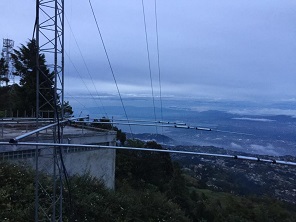 The Operating Experience
The Operating Experience
Starting a contest nearly 20 hours late dictates some mental adjustment and recalculation of goals. I'd missed the entire first night (80 and 40 meter prime time) and most of the best running hours on 15M the first day. Came to the conclusion the best score I could hope for would be achieved by simply running on the band with the best rate and not worrying at all about multipliers (hoping they would find me). Besides, without contest logging software I was operating "blind" with no idea of what multipliers were needed on a band or how many contacts I might have on any band at any point in time. No contest software also meant no access to Super Check Partial to confirm call signs. At least I wouldn't be manual logging. :-)
It took a few hours to get comfortable operating without what over the years have become basic tools. I was probably bothered most by not having VOX. Have never been a foot switch guy and having to manually press the CTRL button (PTT) on thekeyboard for every transmission took some adjustment. The other thing I probably missed most was not being able to move between log entry fields by pressing the space bar key ... something I've done for over forty years using CT, NA, Win-Test and other loggers. It took several hours to automatically press the 'Tab' key after entering a call ... but it took concentration! Later on into the contest having to enter report data for EVERY contact (no report pre-fills after working a station on another band) became rather tedious.
Being the only station active from Haiti certainly attracted a crowd. It's probably been a decade or more since I've had Aruba all to myself in a major contest. I knew what to expect and was prepared for the massive initial response. This was one of the reasons I decided to proceed with the operation even with a somewhat limited tool set... I'm a rate junkie at heart and the prospect of big pileups was terribly appealing!
Needless to say I was not disappointed. The first five hours on 20M Saturday afternoon were consistent 150 hours ... the adrenaline rush was spectacular. Then as I transitioned to 40M and then 80M the pileups continued to be impressive considering I'm running just 100 watts to a 160M OCF wire through an auto tuner. It was heaven!
The only serious shortcoming of the station is the noise from the solar inverter system which covers 160 meters with S9 garbage. The RHR guys think they have a fix but it will have to wait until their next visit. On CW this racket is less disruptive when using narrow filtering. Only K3WW made it through on Top Band in a 'move' QSO from 80M. I tuned a few times, thought I heard K3LR and W3LPL CQing, but never well enough to attempt a QSO.
The Sunday morning sunrise run on 80 and then 40 was better than I had expected but then the morning doldrums set in. Both 20 and 15 opened to EU from the US which forced those of us to the south to take a back seat. The rate dropped like a rock - 20 an hour was the norm until about 1800 when the floodgates opened on 15M, yielding an exciting 177 hour - my best of the contest.
I set up a cluster window on a 2nd laptop during the slow period Sunday morning and watched ten meter call outs all day. Never saw a single spot for the HI8 or KP4 guys so had low expectations for an opening but kept trying some CQs from time to time each hour. There simply was never propagation from HH to the US - disappointing to say the least.
So what about the internet latency issue? To tell you the truth it was rarely noticeable. At times the internet would burp or my laptop would become over burdened and slow down, but this never stopped me from making contacts. Sometimes I'd simply hit a key that I shouldn't have on the keyboard and I'd end up disconnected and would need to restart. But in general, I found remote operation very easy and not all that different than the real thing. Using PTT, I had to be somewhat careful not to let up on the CTRL button too soon, otherwise the final "A" in HH2AA would get cut off (suspect if I had VOX working correctly this would have been a non-issue). No one complained that my audio was unintelligible at any point. And probably most important of all I felt LOUD most of the time. The HH2AA location is a winner.
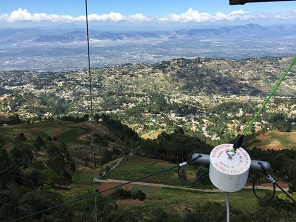 Post Contest
Post Contest
When the bell rang at 2359 UTC I had absolutely no idea how I'd done in my 23 hours of on time. The RHR logger doesn't have a contact counter so the total number of QSOs logged was unknown. Monday morning Lee at RHR sent me a file of ADIF contact records. It was apparent there were almost 2,500 contacts but work was needed to create a log in valid Cabrillo format. During the contest I'd mistakenly entered report data in the wrong log entry field for about 400 contacts near the start, and without an edit check, throughout the weekend at least 50 section abbreviations were entered wrong but still accepted. These are minor things really, but time consuming to fix manually. I used a freeware converter to migrate from ADIF to Cabrillo format records. Fellow FRCer KE2D helped me correct some record format errors. Finally by late Monday evening, (early Tuesday morning), I had a log file I could load on Win-Test and obtain statistics. As expected 20M was my big band but I was impressed by the 40 meter multiplier total given the limited time spent there. I can't help but wonder what the score could have been if the original setup that had worked so well Thursday afternoon were available all weekend.
Bottom line, to me the HH2AA remote operation was an unqualified success despite the 19 hour delayed start and not having basic accessories. I'd love to do it again. Thanks RHR for this opportunity and for your first class support every step of the way!
73,
John, W2GD aka P40W/P44W
less
